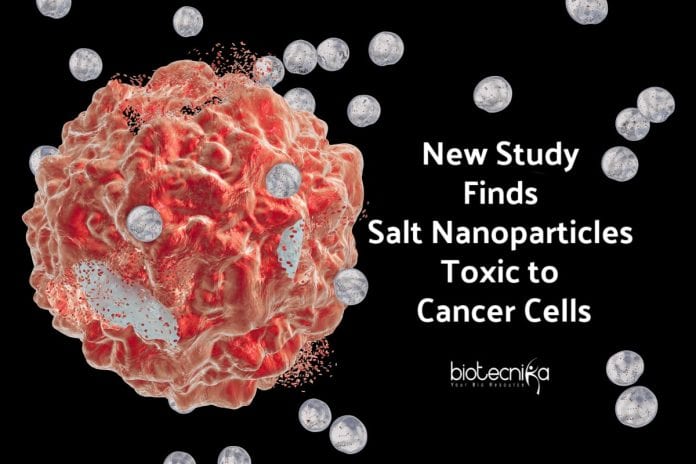Salt Nanoparticles Against Cancer Cells
At the University of Georgia, a new study found a less harmful way to attack cancer cells. Salt or sodium chloride nanoparticles are found to be toxic to cancer cells and they offer the potential for therapies having fewer negative side effects when compared to the treatments currently in use.
An associate professor of Chemistry, Jin Xie, led this study and found that cell death by delivering ions into cells and disrupting their internal environment can be caused by SCNPs, used as a Trojan horse. This is not harmful to the body because when SCNPs degrade, they become salt.
Xie said, “For localized destruction of cancer cells, this technology is well suited. In the treatment of neck, head, liver, prostate and bladder cancer, we expect this technology to find wide applications.
According to Xie and the team of researchers, the key to delivering SCNPs into the cells is nanoparticles. A gradient is maintained by the cell membranes that keep the sodium concentrations relatively high outside cells and relatively low sodium concentrations inside cells. The cell does not recognize the SCNPs as sodium ions, thus the SCNPs are able to pass through the plasma membrane even
though the membrane prevents sodium from entering a cell.SCNPs dissolve into millions of sodium and chloride ions once inside a cell and these ions are trapped inside by the gradient and overwhelm protective mechanisms, causing cell death after the rupture of the plasma membrane. An inflammatory response that helps the body fight pathogens is induced when the molecules leak out due to the rupture of the plasma membrane, which signals the immune system that there’s tissue damage.
Xie said, ” Than to normal cells, this mechanism is way more toxic to cancer cells because the cancer cells’ sodium concentrations are relatively high.”
Injecting SCNPs into tumors using a mouse model, SCNPs were tested as potential cancer therapeutic by Xie and the team. They found that the tumor growth was suppressed by 66% with SCNP treatment when compared to the control group, without any sign of toxicity to major organs or any drop in body weight.
A vaccination study was also performed by inoculating mice with cancer cells that had been killed via free-thaw or SCNPs. It was seen a greater resistance was seen in these mice to a subsequent liver cancer cell challenge, with all animals remaining free from the tumor for more than two weeks.
Using a tumor model, the researchers also explored anti-cancer immunity. By leaving the secondary tumors untreated after injecting primary tumors with SCNPS, it was seen that than the control, the secondary tumors grew at a much slower speed which showed 53% of tumor inhibition rate.
The results collectively suggested that the cancer cells were killed by SCNPs and the dying cancer cells were converted to an in situ vaccine by the SCNPs.
According to Xie, in the world of inorganic particles, SCNPs are unique because their toxicity is based on the nanoparticle form and they are made of benign material
He said, ” Than systemic therapy, SCNPs are best suited for localized therapy as they have a relatively short half-life in aqueous solution. The treatment will cause immunogenic cancer cell death immediately. There is no systematic or accumulative toxicity because after the treatment the nanoparticles are reduced to salts which then merge with the body’s fluid system. When SCNPs were injected at high doses, no sign of systematic toxicity was observed.
Editor’s Note: salt nanoparticles againstcancer






























